The challenge of balancing speed and accuracy is a huge part of what makes shooting a modern sporting rifle so much fun. Whether you are ringing steel at 600 yards from a Daniel Defense .308 or running through a close-quarters tactical drill with an AK-47, the ambition is always the same—achieving the hits you need as quickly as possible.
The best upgrades and accessories will help you put your sights on target faster, help you hit the target with greater precision, or help achieve both of those goals simultaneously. There are a ton of choices out there, so this battle is focused on two of the most popular configurations for the AR-15 carbine—the low-power variable optic (LPVO) versus the red dot and magnifier combo.
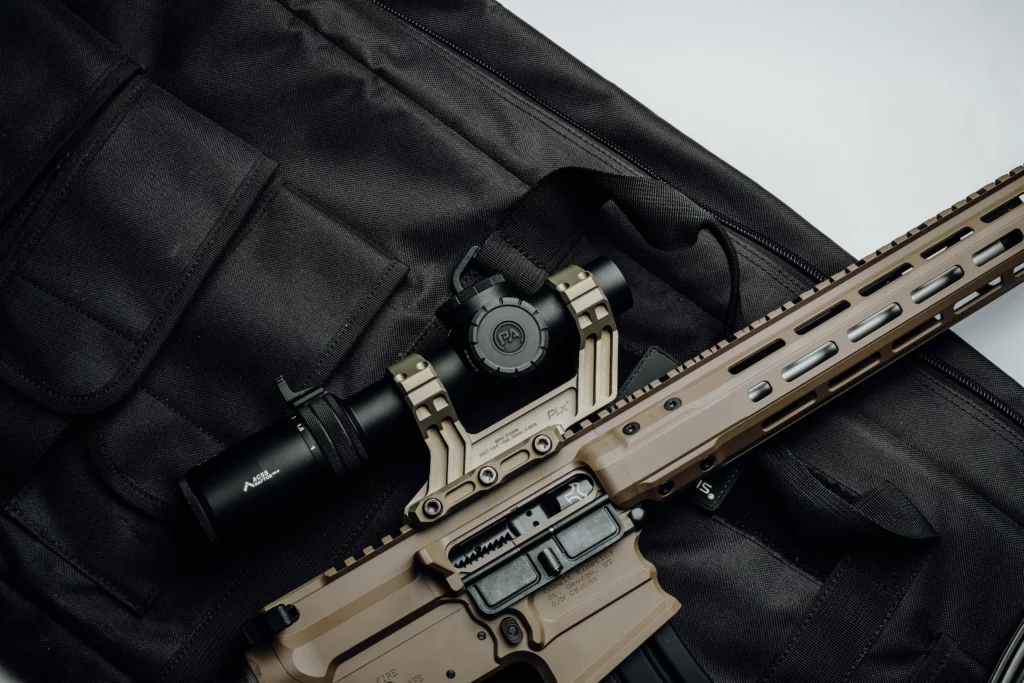
Chat with one of these shooters at the range and they will usually tell you all about which scope they plan on buying! The hot question now isn’t whether AR-15 Scopes are a good idea, but which configuration is the best rifle scope for the money.
Low Power Variable Scopes (LPVO)
Low power variable optics use an etched reticle that your eye sees as a black shape contrasted against the field of view. In more advanced LPVOs, the reticle may be illuminated by battery power, fiber optics, or some other light source.
Unlike the red dot’s reflected light projection reticle, the LPVO’s etched reticle is always present regardless of battery status, although without illumination they can be difficult to use in low light conditions or at night. The science behind etched reticle optics also means LPVOs must cope with visual limitations that just aren’t a factor with red dots.

For example, “eye relief” defines the distance between the ocular lens at the rear of the scope and the ideal placement of your eye. If an LPVO scope has an eye relief of 3.5 inches, placing your eye just 1 inch behind the lens results in an unusable sight picture. Placing your eye 5 inches behind the lens also results in, you guessed it, no sight picture.
The “exit pupil” is the diameter of the shaft of light coming out of the ocular lens, which your eye must line up with to see that etched reticle correctly and take an accurate shot. Move your head too much up or down, side to side, and you’ll see the reticle distort with odd crescent-shaped shadows appearing in the sight picture just before the view goes completely black.
The overall space where your eye can acquire the reticle correctly, allowing you to take an accurate shot, is called the “eye box”. The eye box is difficult to quantify. No manufacturer can put a number on it, but for fast shooting up close a good eye box is absolutely essential in an LPVO.
Exit pupil, and therefore eye box, is dependent on the size of the front or objective lens compared to the magnification setting of the scope. At 1x the eye box on a quality LPVO will be so large and forgiving that it is possible to shoot with both eyes open like a red dot, and almost as quickly. At higher magnifications the eye box will get smaller, your point of aim will seem much more sensitive, and it will take more time to aim your rifle.
The greatest advantage of the low power variable optic is the “variable” part. Shooting up close using both eyes open with a wide view of 1x magnification is a great start, but the magic happens with the ability to crank up magnification until more distant targets seem 4, 6, or even 8 times closer than they are.
When combined with smart reticles like in the Primary Arms Compact PLxC 1-8×24 FFP Rifle Scope with advanced combined sighting system, the LPVO offers precision at medium ranges that no red dot sight can match.
ACSS combines bullet drop compensation, range estimation, wind holds, and moving target leads all into the reticle. Once it is sighted in correctly for your ammunition type and muzzle velocity, you never have to do math or count windage and elevation clicks. The reticle provides visual cues to help you aim using the proper holdover in a huge variety of shooting situations
If your target is a steel plate or a coyote at an unknown distance between 300 and 500 yards, and wind is pushing left to right at 10 mph, a 1-6x LPVO with an ACSS reticle will get you on target with certainty. Comparatively, a 2 moa red dot gives you no help at all in determining the correct aiming point. If you simply place the dot on the target, you are more likely to miss, even if using a magnifier.
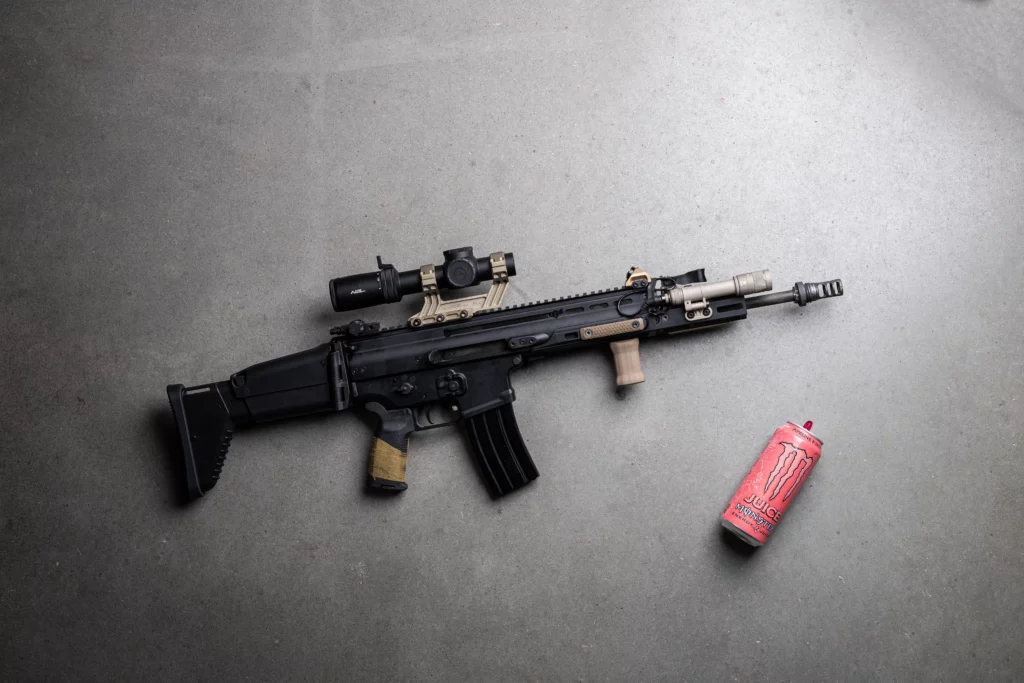
The red dot is great for close to medium ranges but, can be harder to use at longer distances. One notable exception is the Primary Arms MD-25 ACSS-CQB, featuring a unique ACSS reticle with a center chevron and multiple bullet drop compensation dots. The ACSS definitely offers a more intelligent approach to long-distance red dot shooting, but it is an exception, not the rule.
A low power variable optic is a larger, bulkier choice than even a full-size red dot. They take up the entire Picatinny rail section on an AR-15 or AR-308 and add over a pound of weight of your carbine along with the necessary mount.
No matter how much money you spend, it is generally agreed that an LPVO set to 1x magnification will not be as fast, nor as forgiving, as a red dot for close-quarters shooting. With careful scope setup and a lot of practice, the difference can be minimized, but it is still there.
Reticle illumination is never quite as bright as with a red dot, although there are some LPVOs out there that get pretty close, if you are willing to spend more money. However, because of the differences in technology involved, battery life is no comparison at all. There are several micro red dots available with 50,000-hour battery life for as little as $150 with a lifetime warranty, but a 50,000-hour battery life LPVO does not yet exist at any price.
LPVO Pros and Cons
LPVO Pros
– Superior magnification flexibility
– Etched reticle always present even with a dead battery
– More advanced/complex reticles possible
– Superior reticle sharpness for shooters with astigmatism
– Greatly improved accuracy especially past 100 yards
LPVO Cons
– Size and weight penalty vs. Red dot alone
– Can easily cost more than a comparable red dot + magnifier setup
– Not as fast to acquire as a red dot, even at 1x with both eyes open
– Less flexible on mounting locations due to eye box demands
Red Dot Sights
In 1975 a group of american special forces prepared for a night raid to rescue american prisoners of war in north vietnam. Spray-and-pray with iron sights wasn’t going to cut it for a rescue mission in the dark with American lives on the line.
The son tay raiders attached armson “singlepoint” occluded optic gunsights to their rifles, creating the concept of the red dot equipped AR-15 before true red dot sights were even invented. Fast forward more than 40 years and red dots are now the most popular AR-15 tactical optics for fast shooting at closer ranges.
The red dot is king of sight acquisition speed because, unlike a traditional rifle scope, it has no eye relief, exit pupil or eye box. The dot you see when looking through the sight is not projected forward onto the target like a laser but bounced off a curved piece of glass and reflected back towards your eye.
Shop All Primary Arms Red Dot Sights
The limit of your sight picture is the field of view that you see through the sight’s “window”. If you can see the dot at all, even in just a fraction of the scope’s field of view, you can use the dot to take a decently accurate shot, if you must. Looking at a traditional scope from the same angle, you would be unable to get any sight picture at all.
But this doesn’t mean red dots are flawless and have no disadvantages. It’s true that modern red dots have incredible battery life, often measured in years. But if the battery does unexpectedly fail, the red dot loses its sight picture entirely, leaving you with no aiming point at all unless you have back up iron sights to deploy.
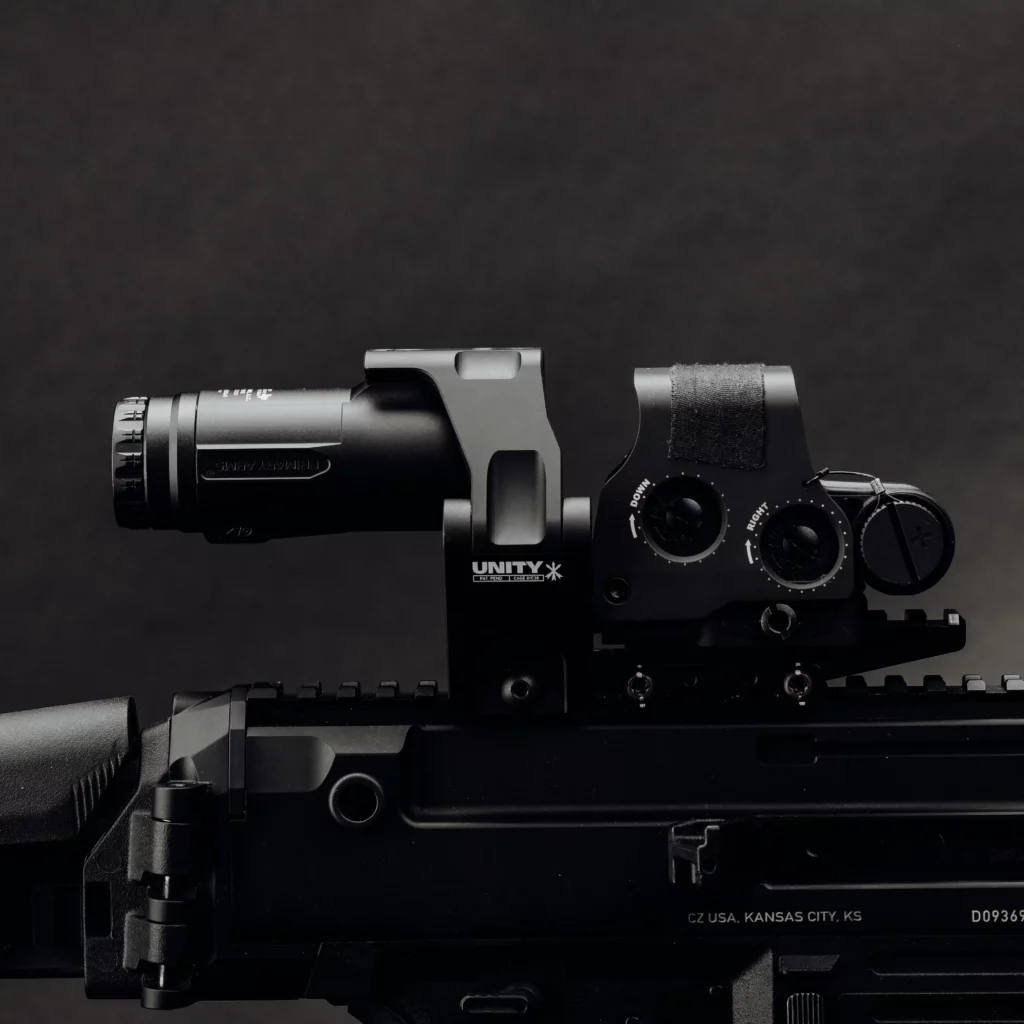
Many shooters with astigmatism or other eye issues don’t see the dot clearly, instead seeing a comet or squiggly lines. Taking an accurate shot with such an undefined point of aim can be difficult or impossible. Some shooters have better luck seeing red dot sights that use holographic weapons sight technology.
EOTech and Vortex holographic sights create the reticle by using a laser diode and collimating reflector rather than an led emitter. While the overall effect looks a lot like a traditional red dot, the technology used to deliver it is different.
Red Dot Scope Pros and Cons
Red Dot Pros
– Best possible sight picture acquisition speed
– Both eyes open shooting is easy for maximum peripheral vision
– Intense reticle brightness grabs the eye instantly even in bright sunlight
– Unsurpassed battery life
– Excellent value per dollar, whether budget red dot or top-of-the-line
Red Dot Cons
– No battery means no sight picture
– No magnification to aid accuracy or target identification
– Eyes with astigmatism or other medical issues struggle with the dot’s appearance
– Exposes truth of dot size relative to the target
How to Get More Range Out of a Red Dot with Magnifiers
The red dot’s simplicity and lack of magnification are its biggest strengths in fast close quarters shooting. Beyond 100 yards, these strengths become the red dot’s greatest weakness. Red dot magnifiers, like the Primary Arms GLx 6x Magnifier, can add some magnification to help the red dot step its game up.
Most commonly, the magnifier is a separate stand-alone optic that is placed behind the red dot in its own mount. Although a fixed mount such as a simple 30mm scope ring can be used to place the magnifier, doing this results in the same disadvantage as the screw-in design—eye relief and eye box limitations of the magnifier lenses (similar to the LPVO) now apply to the red dot as well, so the red dot loses its close quarters speed more or less permanently (until the magnifier is dismounted from the rifle entirely).
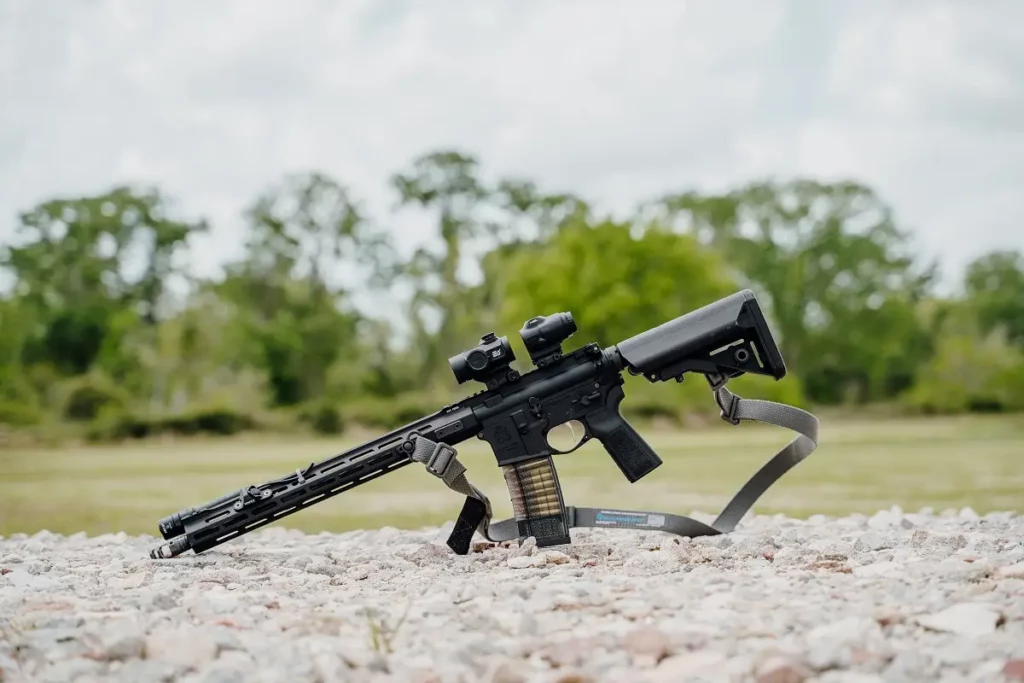
The best mount for a red dot magnifier is a flip-to-side configuration. These mounts place the magnifier behind the red dot for longer-range shots yet allow you to instantly flip the magnifier out of your field of view when desired. 3x or 6x magnification when needed, without subtracting any of the red dot’s advantages when flipped out of the way.
However, while adding a magnifier may add to the disadvantages of traditional optics, like eye relief and eye box, they do give you a very versitle set-up. You may not be able to vary your magnification level you do gain a fast way to reach out a bit further. You can commonly find magnifiers in 3x, 5x, and 6x maginication like the new Primary Arms GLx 6x Magnifier.
Flipping the magnifier out of the way may cause some practical issues that aren’t an issue with the LPVO. The magnifier can tend to snag on things while fliped outward. The magnifier also magnifies your perception of the red dot along with the rest of the field of view.
While the magnification certainly helps with accuracy, that help is limited by the size of the red dot. At 100 yards you will clearly be able to see that a 2 moa dot covers two inches of the target, and a 6 moa dot covers six inches of the target. At 200 yards the 6 moa dot will appear to be about 12 inches wide.
That’s not optimal when compared to the precise reticles available in LPVOs. It is important to realize that the dot size isn’t actually changing—the magnifier just helps you see that dot size better than you can at 1x magnification. One method of addressing this issue is to select a red dot with a chevron aiming point instead of a dot, like the Primary Arms MD-25 ACSS-CQB.
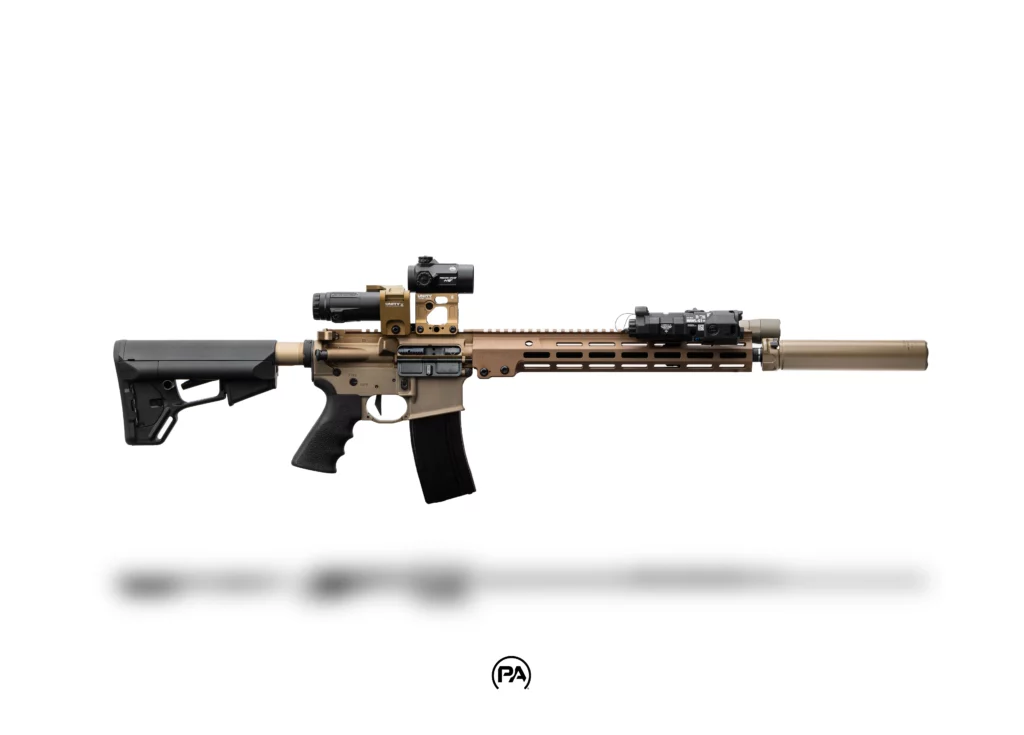
The chevron tip is an infinitely small aiming point that never obscures the target, so that’s an improvement over a simple dot. The MD-25 ACSS pairs wonderfully with a magnifier but adding magnification to the reflected led reticle still doesn’t give you the LPVO’s etched reticle sharpness.
Stand-alone magnifiers start affordably near the $100 mark, with premium models approaching $600. If you will primarily be shooting close to medium range but still want the ability to shoot longer distances, a red dot sight and a magnifier is a great option.
Red Dot Scope with a Magnifier Pros and Cons
Magnifier Pros
– Adds magnification to red dot for better accuracy and target identification
– Does not affect red dot’s benefits when flipped out of the way (dependent on mount type)
– Does not affect zero—can be easily moved from rifle to rifle
Magnifier Cons
– Limited field of view and eyebox, like a fixed power scope
– Can only add one level of magnification
– Adds weight and overall bulk
– Exposes truth of dot size relative to the target
Which Set-Up is Best for You?
Each of these configurations is fast and flexible. When choosing between them, it can be helpful to define your primary shooting objectives versus your secondary shooting objectives, and select the optics choice that boosts performance most in your primary category.
For example, if your primary objective is close-quarters speed shooting, and accuracy at longer distances is secondary, you might decide that the red dot + magnifier fits your needs best. If your primary objective is a balance of speed and accuracy at all ranges from 35 feet to 350 yards, then the low power variable optic might suit your shooting style best.
Carefully consider the type of shooting you intend to do with your AR-15. If you plan on tactical shooting around barricades or vehicles, shooting from unusual and stressful positions, the ability to get a red dot sight picture with an imperfect cheek weld and poor eye alignment becomes a huge advantage. If you plan on doing competitions where you might get just one chance at a “bonus” steel target 300 yards away, the LPVO is the smarter option.
There are also special circumstances where certain shooters or rifle setups can’t take advantage of one system’s benefits in some way. For example, a shooter with astigmatism who has trouble seeing red dots may decide that their eyesight rules out using a red dot under any circumstances, pushing them to the LPVO’s or Prism sight’s etched reticle for all types of shooting.
A short-barreled rifle or AR-15 pistol build will have greatly reduced terminal effect at longer ranges due to reduced muzzle velocity, making longer range shooting impractical. The altered bullet trajectory from a shorter rifle barrel also makes bullet drop compensation reticles incompatible, negating what would normally be an advantage for the LPVO. The best scope choice should match up the rifle’s configuration, so in this case a red dot is the right call.
For some folks the decision comes down to the smaller details. Some red dot shooters hate carrying spare batteries and want the reassurance of incredibly long battery life, or they demand a much brighter reticle than LPVOs can provide.
Some LPVO shooters don’t want to settle for a single magnified setting of 3x or 6x, demanding the ability to seamlessly access all magnifications using a single optic. If one of these distinctions reaches out and grabs you, trust your instincts and run with it—you aren’t wrong!
Use Case Recommendations
Use a red dot + magnifier when
– Ultimate speed up close is most important and targets beyond 200 yards are not a possibility at all
– Using unusual barrel lengths or calibers where a bdc reticle is not available
– You only desire two magnifications, 1x and 3x, or 6x
– You want to leave illumination always on for years at a time
Use a low power variable optic when:
– You anticipate engaging targets as distances over 200 yards
– You can take a bit more time at 1x and want more precision past 100 yards
– You can get a consistent sight picture at all times while shooting
– Your caliber and barrel length match up well with a smart BDC reticle system
– Astigmatism gives you trouble with seeing red dots unlike with LPVOs and Prism sights
– You envision using multiple magnifications depending on situation
If you are researching which optic is right for your next build and you just can’t make up your mind, feel free to call 713-344-9600 or email info@primaryarms.com. Our dedicated customer service team here in Houston, Texas is standing by to help you get a great deal on your perfect optics setup!



